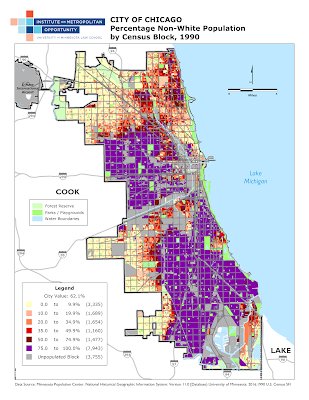Diversity is rapidly increasing in the Twin Cities, with the nonwhite share of population growing from 23 percent to 40 percent in two decades. By contrast, Chicago has been very diverse for a very long time. Segregation in many Chicago neighborhoods is well-established.
Despite this comparative stability - the nonwhite share of population increased by only 6 percent between 1990 and 2010 - you can still see significant neighborhood racial transition over the past twenty years, mostly taking the form of segregation moving west and north.
But there's another phenomenon in Chicago that's not really present in the Twin Cities: a significant degree of gentrification. This is most easily observed in a pocket north of downtown, in neighborhoods like Wicker Park and Bucktown. There, blocks have grown dramatically whiter in very short order, as wealthy in-movers carve out enclaves in what was previously a segregated area. While genuine racial diversity persists around the edges of these enclaves, they appear to be on a trajectory towards white segregation, akin to wealthy suburbs or other exclusionary communities. In other words, severe gentrification alters racial living patterns, but it does not change the underlying reality that Chicago is a city divided by race and income.
The maps for each year are below. Click on them for an enlarged version.
1990:
2000:
2010:




No comments:
Post a Comment